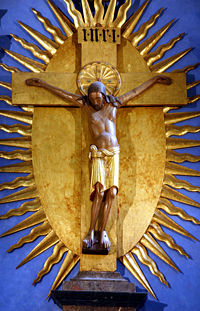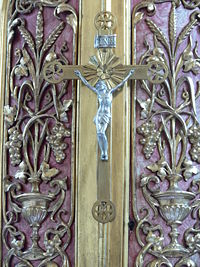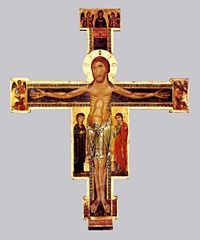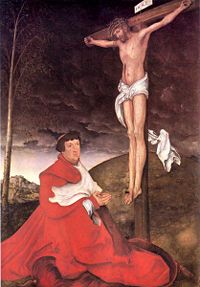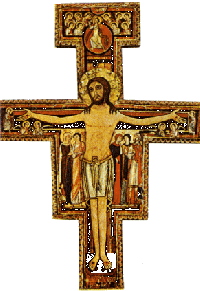Difference between revisions of "Crucifix" - New World Encyclopedia
Anne Inoue (talk | contribs) (adjusting images) |
Anne Inoue (talk | contribs) (image adj, int links, spellcheck) |
||
| Line 1: | Line 1: | ||
| − | [[Image:Gerokreuz full 20050903.jpg|thumb|right|The Crucifix, a cross with ''corpus,'' a symbol used in Anglicanism and Catholicism, in contrast with some Protestant sects, which use only a cross.]] | + | [[Image:Gerokreuz full 20050903.jpg|thumb|right|The Crucifix, a cross with ''corpus,'' a symbol used in Anglicanism and Catholicism, in contrast with some Protestant sects, which use only a cross.|200px]] |
| − | A '''crucifix''' (from [[Latin]] ''cruci fixus,'' meaning "one fixed to a cross") is a [[Christian cross|cross]] with a representation of [[Jesus]]' body, or corpus. It is a principal symbol of the [[Christianity|Christian]] [[religion]], primarily used in the [[Catholic]], [[Anglican]], and [[Eastern Orthodox]] Churches. It emphasizes Christ's sacrifice—his death by [[crucifixion]], his subsequent resurrection, and the grace and rebirth that he offers to believers. This history of the crucifix goes back to the beginning of Christianity, and Christ's death on the cross. However, it was originally seen as a | + | A '''crucifix''' (from [[Latin]] ''cruci fixus,'' meaning "one fixed to a cross") is a [[Christian cross|cross]] with a representation of [[Jesus]]' body, or corpus. It is a principal symbol of the [[Christianity|Christian]] [[religion]], primarily used in the [[Catholic]], [[Anglican]], and [[Eastern Orthodox]] Churches. It emphasizes Christ's sacrifice—his death by [[crucifixion]], his subsequent [[resurrection]], and the [[grace]] and [[rebirth]] that he offers to believers. This history of the crucifix goes back to the beginning of [[Christianity]], and Christ's death on the cross. However, it was originally seen as a grotesque symbol, a sign of death. It was only over time that the crucifix, through its many phases, was imbued with the meanings it now holds for Christian believers. |
| − | The crucifix is a reminder of the trials and tribulations that human beings face and the hope that comes from the redemption offered | + | The crucifix is a reminder of the trials and tribulations that human beings face and the hope that comes from the redemption offered through Christ's death on the cross to those who believe. It is a fusion of [[art]] and [[faith]], and has been a consistent symbol of Catholicism for over 1500 years. |
== Overview == | == Overview == | ||
| − | [[Image:Aitrach Pfarrkirche Tabernakel Kruzifix.jpg|A ornate crucifix made in metals, from the altar of the Church of St. Gordianus und Epimachus, Aitrach, Landkreis Ravensburg.|thumb| | + | [[Image:Aitrach Pfarrkirche Tabernakel Kruzifix.jpg|A ornate crucifix made in metals, from the altar of the Church of St. Gordianus und Epimachus, Aitrach, Landkreis Ravensburg.|thumb|left|200px]] |
| − | A crucifix is commonly regarded as a depiction of the death of Jesus Christ by crucifixion. As such, a representation of Jesus is placed upon a cross of similar proportions to those used by Romans during crucifixions. It can be represented in painting, sculpture, metalwork, and other material art forms. It is often the principal ornament placed upon the altar in a Catholic sanctuary.<ref name=advent>Catholic Encyclopedia, [http://www.newadvent.org/cathen/01352a.htm Altar Crucifix.] Retrieved July 16, 2008.</ref> It is commonly referred to and displayed on Christian monuments. Crucifixes often adorn [[rosary|rosaries]] and are a source of inspiration for many Christians. A crucifix is often inscribed with the letters INRI, an acronym for (translated from Latin), "Jesus of | + | A crucifix is commonly regarded as a depiction of the [[death]] of [[Jesus Christ]] by [[crucifixion]]. As such, a representation of Jesus is placed upon a cross of similar proportions to those used by [[Roman Empire|Romans]] during crucifixions. It can be represented in [[painting]], [[sculpture]], [[metalworking|metalwork]], and other material [[art]] forms. It is often the principal ornament placed upon the [[altar]] in a Catholic sanctuary.<ref name=advent>Catholic Encyclopedia, [http://www.newadvent.org/cathen/01352a.htm Altar Crucifix.] Retrieved July 16, 2008.</ref> It is commonly referred to and displayed on Christian monuments. Crucifixes often adorn [[rosary|rosaries]] and are a source of inspiration for many Christians. A crucifix is often inscribed with the letters [[INRI]], an acronym for (translated from Latin), "Jesus of Nazareth, King of the Jews."<ref name=hutchinson>Hutchinson Encyclopedia, [http://encyclopedia.farlex.com/crucifix Crucifix.] Retrieved July 15, 2008.</ref> |
| − | A crucifix serves as a symbol and a reminder of Christ's journey to earth, his trials and death at the hands of humanity, and his victory over death. It signifies the choice people are given to believe in Jesus or not to believe. It can also represent his brutal death, offering an example for people to follow during hard times or difficult tasks. There are almost countless meanings that can be derived from the crucifix, and as such, there are numerous styles that have crept into Christian art over the past 2000 years. | + | A crucifix serves as a [[symbol]] and a reminder of Christ's journey to [[earth]], his trials and [[death]] at the hands of [[humanity]], and his victory over death. It signifies the choice people are given to believe in Jesus or not to believe. It can also represent his brutal death, offering an example for people to follow during hard times or difficult tasks. There are almost countless meanings that can be derived from the crucifix, and as such, there are numerous styles that have crept into [[Christian art]] over the past 2000 years. |
| + | [[Image:Icon 03032 Raspyatie s predstoyaschimi.jpg|right|200px|An Eastern Orthodox crucifix, showing the nameplate on the upper part of the stand, with the inscription I.N.R.I., and a stipes on the lower part where Jesus' feet were nailed.|thumb]] | ||
| + | On some crucifixes, a [[skull and crossbones]] are shown below the [[corpus]], referring to [[Golgotha]] (Calvary), the site at which Jesus was crucified—"the place of the skull." It was probably called "Golgotha" because it was a burial-place, or possibly because of a legend that the place of Jesus' crucifixion was also the burial place of [[Adam and Eve|Adam]]. The standard, four-pointed Latin crucifix consists of an upright stand and a crosspiece to which the sufferer's arms were nailed. | ||
| − | + | The [[Eastern Christian]] crucifix includes two additional crossbars: The shorter nameplate, located in the upper portion of the stand, to which [[INRI]] was affixed; and the ''stipes'', near the bottom of the stand, to which the feet were nailed, which is angled upward toward penitent thief St. Dismas (to the viewer's left) and downward toward impenitent thief Gestas (to the viewer's right). It is thus eight-pointed. The majority of Eastern crucifixes tend to be two-dimensional [[icon]]s that show Jesus as already dead, as opposed to the depictions of the still-suffering Jesus that can be found in some other [[Church]]es. Also, Eastern crucifixes have Jesus' two feet nailed side by side, rather than one atop the other, as Western crucifixes do. The [[crown of thorns]] is also generally absent in Eastern crucifixes. | |
| − | |||
| − | The [[Eastern Christian]] crucifix includes two additional crossbars: The shorter nameplate, located in the upper portion of the stand, to which [[INRI]] was affixed; and the ''stipes'', near the bottom of the stand, to which the feet were nailed, which is angled upward toward penitent thief St. Dismas (to the viewer's left) and downward toward impenitent thief Gestas (to the viewer's right). It is thus eight-pointed. The majority of Eastern crucifixes tend to be two-dimensional [[icon]]s that show Jesus as already dead, as opposed to the depictions of the still-suffering Jesus that can be found in some other | ||
| − | Another depiction sometimes used portrays a triumphant risen Christ (clothed in robes, rather than stripped as for his execution) with arms raised, appearing to rise up from the cross, sometimes accompanied by "rays of light." | + | Another depiction sometimes used portrays a triumphant [[risen Christ]] (clothed in robes, rather than stripped as for his execution) with arms raised, appearing to rise up from the cross, sometimes accompanied by "rays of light." |
==History== | ==History== | ||
| − | The image of the cross itself is nearly timeless, in both the East and the West, far predating Christianity itself in the form of two intersecting lines at right angles to each other.<ref name=advent>Catholic Encyclopedia, [Archaeology of the Cross and Crucifix.] Retrieved July 15, 2008.</ref> While early Christians avoided the use of even this simple cross, not to mention any rendering of Jesus' crucifixion, the cross came into use no later than the fifth century, with archaeological evidence placing the first surviving image of a crucified Jesus in fifth-century Rome. Earlier renderings depicted Jesus as a lamb, and Christians tended to focus more on Jesus' divine attributes than his earthly presence. And yet, while there is little evidence to support it, there are references to Christians by the year 200 who would decorate themselves with a cross to differentiate themselves from | + | [[Image:Berlinghiero Berlinghieri 001.jpg|200px|left|thumb|A thirteenth century crucifix, depicting Jesus with a calm face.]] |
| − | [[Image: | + | |
| − | In 629 C.E., the Council of Constantinople ordered that, "instead of the lamb, our Lord Jesus Christ will be shown hereafter in His human form in images so that we shall be led to remember His mortal life, His passion, and His death, which paid the ransom for mankind."<ref name=info>Roman Catholic Info, [http://romancatholicinfo.com/catholic-news/catholic-crucifix/ Catholic Crucifix.] Retrieved July 18, 2008.</ref> However, the crucifix itself would have to wait until the Middle Ages to find widespread popularity. In these images, Jesus was depicted with open eyes and a calm face—no trace of pain—reflecting the a prevalent theological emphasis on the | + | The image of the cross itself is nearly timeless, in both [[the East]]] and [[the West]], far predating Christianity itself in the form of two intersecting lines at right angles to each other.<ref name=advent>Catholic Encyclopedia, [Archaeology of the Cross and Crucifix.] Retrieved July 15, 2008.</ref> While early Christians avoided the use of even this simple cross, not to mention any rendering of Jesus' [[crucifixion]], the cross came into use no later than the fifth century, with [[archaeology|archaeological]] evidence placing the first surviving image of a crucified Jesus in fifth-century Rome. Earlier renderings depicted Jesus as a [[lamb]], and Christians tended to focus more on Jesus' [[divinity|divine]] attributes than his earthly presence. And yet, while there is little evidence to support it, there are references to Christians by the year 200 who would decorate themselves with a cross to differentiate themselves from [[Pagan]]s during common daily life.<ref name=advent/> |
| − | + | [[Image:Albrecht-v-Brandenburg-1520.jpg|In the Renaissance, crucifix show an optomistic figure of Christ with lowered eyes, not emphasizing his pain and suffering. ''Albrecht von Brandenburg'' by Lucas Cranach ca. C.E. 1520-25|right|200px|thumb]] | |
| − | During the fifteenth century, Renaissance painters and sculptors further refined the image of Christ on the cross, representing Jesus with his arms outstretched and his head bowed and eyes closed, but his body no longer wretched and in pain. In accordance with the prevailing spirit of the day, Jesus often displayed [[serenity]] and [[grace]]. This Jesus was nothing less than an optimistic figure, standing in stark contrast with medieval interpretations. In this way, Jesus represented the earthly perfection of a new Adam.<ref name=wadsworth/> | + | In 629 C.E., the Council of Constantinople ordered that, "instead of the lamb, our Lord Jesus Christ will be shown hereafter in His human form in images so that we shall be led to remember His mortal life, His passion, and His death, which paid the ransom for mankind."<ref name=info>Roman Catholic Info, [http://romancatholicinfo.com/catholic-news/catholic-crucifix/ Catholic Crucifix.] Retrieved July 18, 2008.</ref> However, the crucifix itself would have to wait until the Middle Ages to find widespread popularity. In these images, Jesus was depicted with open eyes and a calm face—no trace of pain—reflecting the a prevalent [[theology|theological]] emphasis on the [[resurrection]]—and, hence, Jesus' immunity against suffering and death. By the thirteenth century, the crucifix had begun to show the body of Jesus as twisted and bleeding on the cross, as the importance of the [[incarnation]] and the humanity of Jesus grew. This new crucifix became the centerpiece in many churches and cathedrals, a favored object of contemplation. This may partially be because the [[medieval]] Catholic Church placed suffering at the heart of its salvation doctrine. Indeed, Catholics were expected to "crucify" their own human nature, in imitation of the suffering of Jesus.<ref name=wadsworth>Thompson Wadsworth, [http://www.wadsworth.com/religion_d/special_features/symbols/crucifix.html Crucifix.] Retrieved July 16, 2008.</ref> |
| + | |||
| + | During the fifteenth century, [[Renaissance]] [[painters]] and [[sculptors]] further refined the image of [[Christ]] on the cross, representing Jesus with his arms outstretched and his head bowed and eyes closed, but his body no longer wretched and in pain. In accordance with the prevailing spirit of the day, Jesus often displayed [[serenity]] and [[grace]]. This Jesus was nothing less than an optimistic figure, standing in stark contrast with medieval interpretations. In this way, Jesus represented the earthly perfection of a new [[Adam]].<ref name=wadsworth/> | ||
| + | |||
| + | [[Protestant]]s, however, took a dim view of the crucifix. This was reinforced during the [[Reformation]], when Protestants repudiated most representational religious images. Hence, the cross became even more associated with [[Catholicism]].<ref name=believe>Believe, [http://mb-soft.com/believe/txn/cross.htm Crucifix, Cross General Information.] Retrieved July 15, 2008.</ref> Strong [[reformation]]ists saw the crucifix as an example of idolatry and tied it closely with the Catholic church. While this viewpoint has largely resolved in the last century or so, the crucifix is still seen as an object that is almost exclusively belonging to Catholic Christianity. | ||
| − | |||
| − | |||
== Crucifix vs. cross == | == Crucifix vs. cross == | ||
| − | Anglican, Roman Catholic, Orthodox, and Coptic Christians generally use the crucifix in public religious services. They believe the crucifix is in keeping with Scripture, which states that, “We preach Christ crucified, unto the Jews a stumbling block, and unto the Greeks foolishness.”<ref>Mount Calvary, [http://www.mountcalvary.com/sermons_2006/2006_09_17.php Sermon for September 17, 2006.] Retrieved July 16, 2008.</ref> | + | [[image:Crucifix.JPG|thumb|left|200px|A crucifix amidst the cornfields near Mureck in rural [[Styria (state)|Styria]], [[Austria]]]] |
| + | [[Anglican]], [[Roman Catholic]], [[Orthodox]], and [[Coptic]] Christians generally use the crucifix in public religious services. They believe the crucifix is in keeping with Scripture, which states that, “We preach Christ crucified, unto the Jews a stumbling block, and unto the Greeks foolishness.”<ref>Mount Calvary, [http://www.mountcalvary.com/sermons_2006/2006_09_17.php Sermon for September 17, 2006.] Retrieved July 16, 2008.</ref> | ||
| − | Prayer in front of a cross or crucifix is often part of devotion for Christians, especially those worshiping in a church, and private devotion in a chapel. The person may sit, stand, or kneel in front of the crucifix, sometimes looking at it in contemplation, or merely in front of it with head bowed or eyes closed. In the Roman Catholic Mass, and [[Anglican]] Holy Eucharist, a [[procession]] begins [[Mass]] in which a crucifix is carried forward into the church followed by lector and servers, the priest, deacon, along with some of the other items used in the service such as the [[Gospels]] and the altar candles. Eastern Christian liturgical processions also include a crucifix at the head of the [[crucession|procession]]. | + | Prayer in front of a cross or crucifix is often part of [[devotion]] for Christians, especially those worshiping in a church, and private devotion in a chapel. The person may sit, stand, or kneel in front of the crucifix, sometimes looking at it in [[contemplation]], or merely in front of it with head bowed or eyes closed. In the Roman Catholic Mass, and [[Anglican]] Holy Eucharist, a [[procession]] begins [[Mass]] in which a crucifix is carried forward into the church followed by lector and servers, the [[priest]], [[deacon]], along with some of the other items used in the service such as the [[Gospels]] and the altar candles. [[Eastern Christian]] liturgical processions also include a crucifix at the head of the [[crucession|procession]]. |
The crucifix is also considered by some to be one of the most effective means of averting or opposing [[demons]], as stated by many [[exorcists]], including the famous exorcist of the Vatican, Father [[Gabriele Amorth]]. In folklore it is considered to ward off [[vampires]], [[incubi]], [[succubi]], and other evils. | The crucifix is also considered by some to be one of the most effective means of averting or opposing [[demons]], as stated by many [[exorcists]], including the famous exorcist of the Vatican, Father [[Gabriele Amorth]]. In folklore it is considered to ward off [[vampires]], [[incubi]], [[succubi]], and other evils. | ||
| − | It should be noted that a cross and crucifix are related, but not the same thing. While the crucifix does indeed use the symbol of the cross as its backbone, what makes it unique is the added element of Christ's body. There are those that believe that the empty cross is a more powerful symbol, as it emphasizes the fact that Christ is no longer there and his triumph over death. Most Protestant Christians who use the cross as a symbol use the empty cross. However, the Catholic tradition prefers to place emphasis on Christ's death for the sins of humanity—his resurrection would not have happened had he not died on the cross first. And, thus, this aspect of theology is emphasized in the crucifix. | + | It should be noted that a [[cross]] and crucifix are related, but not the same thing. While the crucifix does indeed use the symbol of the cross as its backbone, what makes it unique is the added element of Christ's body. There are those that believe that the empty cross is a more powerful symbol, as it emphasizes the fact that Christ is no longer there and his triumph over death. Most Protestant Christians who use the cross as a symbol use the empty cross. However, the Catholic tradition prefers to place emphasis on Christ's death for the sins of humanity—his resurrection would not have happened had he not died on the cross first. And, thus, this aspect of theology is emphasized in the crucifix. |
==Types of crucifix== | ==Types of crucifix== | ||
There are many different types of crucifixes, limited only by the imagination of the artists. Listed below are only two examples of the plethora of varieties. | There are many different types of crucifixes, limited only by the imagination of the artists. Listed below are only two examples of the plethora of varieties. | ||
| − | [[Image:Kruis san damiano.gif|right| | + | [[Image:Kruis san damiano.gif|right|200px|An example of a crucifix in the style of the San Dimiano Crucifix.|thumb]] |
'''San Damiano Crucifix''' | '''San Damiano Crucifix''' | ||
The San Damiano Crucifix was first designed by an eleventh or twelfth century Umbrian artist, adorning the chapel of San Damiano, in Assisi, Italy. Since that time innumerable variatiosn have been made in similar a style. The San Diamiano crucifix depicts events seen in the Passion of Christ. At the top, Jesus ascends into Heaven, his hand outstretched towards the hand of his Father. The Virgin Mary and John stand to Christ's right. To Christ's left stand Mary Magdalen, Mary Cleophas (the mother of James), and a Roman Centurion.<ref name=fisheaters>Fisheaters, [http://www.fisheaters.com/crucifixes.html Crucifixes.] Retrieved July 18, 2008.</ref> Beside Jesus' right leg is Adam biting into the Apple, and at the very bottom of the crucifix are 6 unknown Saints. | The San Damiano Crucifix was first designed by an eleventh or twelfth century Umbrian artist, adorning the chapel of San Damiano, in Assisi, Italy. Since that time innumerable variatiosn have been made in similar a style. The San Diamiano crucifix depicts events seen in the Passion of Christ. At the top, Jesus ascends into Heaven, his hand outstretched towards the hand of his Father. The Virgin Mary and John stand to Christ's right. To Christ's left stand Mary Magdalen, Mary Cleophas (the mother of James), and a Roman Centurion.<ref name=fisheaters>Fisheaters, [http://www.fisheaters.com/crucifixes.html Crucifixes.] Retrieved July 18, 2008.</ref> Beside Jesus' right leg is Adam biting into the Apple, and at the very bottom of the crucifix are 6 unknown Saints. | ||
Revision as of 17:05, 16 August 2008
A crucifix (from Latin cruci fixus, meaning "one fixed to a cross") is a cross with a representation of Jesus' body, or corpus. It is a principal symbol of the Christian religion, primarily used in the Catholic, Anglican, and Eastern Orthodox Churches. It emphasizes Christ's sacrifice—his death by crucifixion, his subsequent resurrection, and the grace and rebirth that he offers to believers. This history of the crucifix goes back to the beginning of Christianity, and Christ's death on the cross. However, it was originally seen as a grotesque symbol, a sign of death. It was only over time that the crucifix, through its many phases, was imbued with the meanings it now holds for Christian believers.
The crucifix is a reminder of the trials and tribulations that human beings face and the hope that comes from the redemption offered through Christ's death on the cross to those who believe. It is a fusion of art and faith, and has been a consistent symbol of Catholicism for over 1500 years.
Overview
A crucifix is commonly regarded as a depiction of the death of Jesus Christ by crucifixion. As such, a representation of Jesus is placed upon a cross of similar proportions to those used by Romans during crucifixions. It can be represented in painting, sculpture, metalwork, and other material art forms. It is often the principal ornament placed upon the altar in a Catholic sanctuary.[1] It is commonly referred to and displayed on Christian monuments. Crucifixes often adorn rosaries and are a source of inspiration for many Christians. A crucifix is often inscribed with the letters INRI, an acronym for (translated from Latin), "Jesus of Nazareth, King of the Jews."[2]
A crucifix serves as a symbol and a reminder of Christ's journey to earth, his trials and death at the hands of humanity, and his victory over death. It signifies the choice people are given to believe in Jesus or not to believe. It can also represent his brutal death, offering an example for people to follow during hard times or difficult tasks. There are almost countless meanings that can be derived from the crucifix, and as such, there are numerous styles that have crept into Christian art over the past 2000 years.
On some crucifixes, a skull and crossbones are shown below the corpus, referring to Golgotha (Calvary), the site at which Jesus was crucified—"the place of the skull." It was probably called "Golgotha" because it was a burial-place, or possibly because of a legend that the place of Jesus' crucifixion was also the burial place of Adam. The standard, four-pointed Latin crucifix consists of an upright stand and a crosspiece to which the sufferer's arms were nailed.
The Eastern Christian crucifix includes two additional crossbars: The shorter nameplate, located in the upper portion of the stand, to which INRI was affixed; and the stipes, near the bottom of the stand, to which the feet were nailed, which is angled upward toward penitent thief St. Dismas (to the viewer's left) and downward toward impenitent thief Gestas (to the viewer's right). It is thus eight-pointed. The majority of Eastern crucifixes tend to be two-dimensional icons that show Jesus as already dead, as opposed to the depictions of the still-suffering Jesus that can be found in some other Churches. Also, Eastern crucifixes have Jesus' two feet nailed side by side, rather than one atop the other, as Western crucifixes do. The crown of thorns is also generally absent in Eastern crucifixes.
Another depiction sometimes used portrays a triumphant risen Christ (clothed in robes, rather than stripped as for his execution) with arms raised, appearing to rise up from the cross, sometimes accompanied by "rays of light."
History
The image of the cross itself is nearly timeless, in both the East] and the West, far predating Christianity itself in the form of two intersecting lines at right angles to each other.[1] While early Christians avoided the use of even this simple cross, not to mention any rendering of Jesus' crucifixion, the cross came into use no later than the fifth century, with archaeological evidence placing the first surviving image of a crucified Jesus in fifth-century Rome. Earlier renderings depicted Jesus as a lamb, and Christians tended to focus more on Jesus' divine attributes than his earthly presence. And yet, while there is little evidence to support it, there are references to Christians by the year 200 who would decorate themselves with a cross to differentiate themselves from Pagans during common daily life.[1]
In 629 C.E., the Council of Constantinople ordered that, "instead of the lamb, our Lord Jesus Christ will be shown hereafter in His human form in images so that we shall be led to remember His mortal life, His passion, and His death, which paid the ransom for mankind."[3] However, the crucifix itself would have to wait until the Middle Ages to find widespread popularity. In these images, Jesus was depicted with open eyes and a calm face—no trace of pain—reflecting the a prevalent theological emphasis on the resurrection—and, hence, Jesus' immunity against suffering and death. By the thirteenth century, the crucifix had begun to show the body of Jesus as twisted and bleeding on the cross, as the importance of the incarnation and the humanity of Jesus grew. This new crucifix became the centerpiece in many churches and cathedrals, a favored object of contemplation. This may partially be because the medieval Catholic Church placed suffering at the heart of its salvation doctrine. Indeed, Catholics were expected to "crucify" their own human nature, in imitation of the suffering of Jesus.[4]
During the fifteenth century, Renaissance painters and sculptors further refined the image of Christ on the cross, representing Jesus with his arms outstretched and his head bowed and eyes closed, but his body no longer wretched and in pain. In accordance with the prevailing spirit of the day, Jesus often displayed serenity and grace. This Jesus was nothing less than an optimistic figure, standing in stark contrast with medieval interpretations. In this way, Jesus represented the earthly perfection of a new Adam.[4]
Protestants, however, took a dim view of the crucifix. This was reinforced during the Reformation, when Protestants repudiated most representational religious images. Hence, the cross became even more associated with Catholicism.[5] Strong reformationists saw the crucifix as an example of idolatry and tied it closely with the Catholic church. While this viewpoint has largely resolved in the last century or so, the crucifix is still seen as an object that is almost exclusively belonging to Catholic Christianity.
Crucifix vs. cross
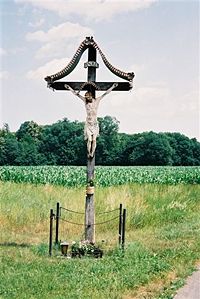
Anglican, Roman Catholic, Orthodox, and Coptic Christians generally use the crucifix in public religious services. They believe the crucifix is in keeping with Scripture, which states that, “We preach Christ crucified, unto the Jews a stumbling block, and unto the Greeks foolishness.”[6]
Prayer in front of a cross or crucifix is often part of devotion for Christians, especially those worshiping in a church, and private devotion in a chapel. The person may sit, stand, or kneel in front of the crucifix, sometimes looking at it in contemplation, or merely in front of it with head bowed or eyes closed. In the Roman Catholic Mass, and Anglican Holy Eucharist, a procession begins Mass in which a crucifix is carried forward into the church followed by lector and servers, the priest, deacon, along with some of the other items used in the service such as the Gospels and the altar candles. Eastern Christian liturgical processions also include a crucifix at the head of the procession.
The crucifix is also considered by some to be one of the most effective means of averting or opposing demons, as stated by many exorcists, including the famous exorcist of the Vatican, Father Gabriele Amorth. In folklore it is considered to ward off vampires, incubi, succubi, and other evils.
It should be noted that a cross and crucifix are related, but not the same thing. While the crucifix does indeed use the symbol of the cross as its backbone, what makes it unique is the added element of Christ's body. There are those that believe that the empty cross is a more powerful symbol, as it emphasizes the fact that Christ is no longer there and his triumph over death. Most Protestant Christians who use the cross as a symbol use the empty cross. However, the Catholic tradition prefers to place emphasis on Christ's death for the sins of humanity—his resurrection would not have happened had he not died on the cross first. And, thus, this aspect of theology is emphasized in the crucifix.
Types of crucifix
There are many different types of crucifixes, limited only by the imagination of the artists. Listed below are only two examples of the plethora of varieties.
San Damiano Crucifix The San Damiano Crucifix was first designed by an eleventh or twelfth century Umbrian artist, adorning the chapel of San Damiano, in Assisi, Italy. Since that time innumerable variatiosn have been made in similar a style. The San Diamiano crucifix depicts events seen in the Passion of Christ. At the top, Jesus ascends into Heaven, his hand outstretched towards the hand of his Father. The Virgin Mary and John stand to Christ's right. To Christ's left stand Mary Magdalen, Mary Cleophas (the mother of James), and a Roman Centurion.[7] Beside Jesus' right leg is Adam biting into the Apple, and at the very bottom of the crucifix are 6 unknown Saints.
The Pardon Crucifix This crucifix was very important to Popes who granted indulgences, such as Pope Pius X. Whoever carried this crucifix was granted an indulgence. On the back of the crucifix are the words, "Father, forgive them."[7] On the long arm of the cross are the words, "Behold this heart which has so loved men," and the Sacred Heart is then shown where the tow arms of the cross meet.[7]
Notes
- ↑ 1.0 1.1 1.2 Catholic Encyclopedia, Altar Crucifix. Retrieved July 16, 2008. Cite error: Invalid
<ref>tag; name "advent" defined multiple times with different content - ↑ Hutchinson Encyclopedia, Crucifix. Retrieved July 15, 2008.
- ↑ Roman Catholic Info, Catholic Crucifix. Retrieved July 18, 2008.
- ↑ 4.0 4.1 Thompson Wadsworth, Crucifix. Retrieved July 16, 2008.
- ↑ Believe, Crucifix, Cross General Information. Retrieved July 15, 2008.
- ↑ Mount Calvary, Sermon for September 17, 2006. Retrieved July 16, 2008.
- ↑ 7.0 7.1 7.2 Fisheaters, Crucifixes. Retrieved July 18, 2008.
External links
All links retrieved July 16, 2008.
Credits
New World Encyclopedia writers and editors rewrote and completed the Wikipedia article in accordance with New World Encyclopedia standards. This article abides by terms of the Creative Commons CC-by-sa 3.0 License (CC-by-sa), which may be used and disseminated with proper attribution. Credit is due under the terms of this license that can reference both the New World Encyclopedia contributors and the selfless volunteer contributors of the Wikimedia Foundation. To cite this article click here for a list of acceptable citing formats.The history of earlier contributions by wikipedians is accessible to researchers here:
The history of this article since it was imported to New World Encyclopedia:
Note: Some restrictions may apply to use of individual images which are separately licensed.
